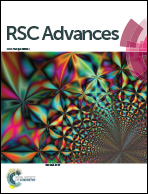Clindanones A and B and cladosporols F and G, polyketides from the deep-sea derived fungus Cladosporium cladosporioides HDN14-342†
Abstract
Four new tetralone derivatives, clindanones A and B (1 and 2) and cladosporols F and G (3 and 4), together with three known biogenetically related polyketides (5–7), were isolated from the deep-sea derived fungus Cladosporium cladosporioides HDN14-342. The structures of 1–4, including absolute configurations, were deduced based on MS, NMR and TD-DFT calculations of specific ECD spectra. The absolute configurations of the known cladosporols C (5) and E (6) were also revised. Compounds 1 and 2 possessed new dimeric forms of the skeleton composed by coupling of indanone and 1-tetralone units, and 4 showed the best cytotoxic activity against HeLa cells with an IC50 value of 3.9 μM.


 Please wait while we load your content...
Please wait while we load your content...